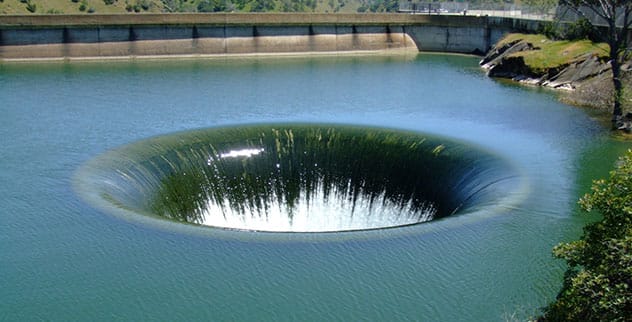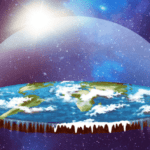Remember how we’ve talked about those peculiar, almost unbelievable spots in the real world? The kind that, if you found them in a video game, you’d suspect a cheeky developer hid them for you to find? Some are spooky, others hilarious, and many are simply awe-inspiring. They all seem to exist to reward the observant explorer with something utterly out of the ordinary.
Well, the world is a treasure trove of such oddities, and our last adventure was so much fun that we’ve dug up ten more. Earth has been a wonderfully weird and mysterious place for ages, and it keeps serving up material for lists like this. So, let’s dive into more real-world locations where it feels like someone tucked away a special surprise, just for you!
1. The Skinny House, Boston
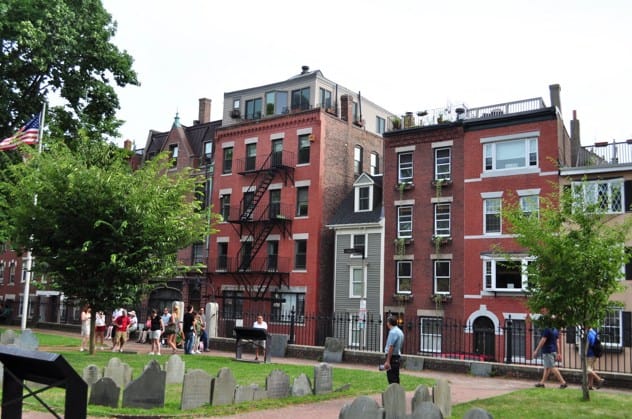
Nestled along the Freedom Trail on Hull Street in Boston, among rows of otherwise ordinary buildings, an architectural anomaly stands out—if you don’t blink and miss it. Known as the Skinny House, it proudly holds the title of the “uncontested narrowest house in Boston.”
Local tales offer various explanations for its existence, but the most common story paints it as a “spite house.” Legend has it that the house was built on a tiny sliver of land left after one of two brothers, while the other was away at war, constructed a large house on their inherited plot. Upon his return, the soldier brother, finding only a small strip remaining, built the narrow house to block his sibling’s sunlight and views. This four-story home measures just over ten feet at its widest point and tapers to a mere six feet at its narrowest, allowing an adult to touch opposite walls simultaneously. The Boston Globe once described its occupants as living a “vertical life.”
2. The Tomb of Christ, Shingo, Japan

In the small Japanese village of Shingo, a peculiar legend centers around its primary tourist attraction: a large cross accompanied by a plaque claiming it as the burial site of Jesus Christ. This, of course, contradicts the widely accepted narrative of events that took place far from Japan.
The legend gained traction in 1935 when a local discovered alleged Hebrew-language documents known as the Takenouchi documents. According to these texts, Jesus didn’t die on the cross. Instead, his brother Isukiri took his place, while Jesus fled to Japan, became a rice farmer, married, had children, and eventually died of natural causes at the age of 106. The Sawaguchi family of Shingo are said to be his direct descendants, though they are Buddhists and reportedly don’t take the claim too seriously. The documents themselves conveniently vanished and were said to also detail ancient aliens and Atlantis, adding to the skepticism. Nevertheless, hundreds of tourists and journalists visit the “Grave of Japanese Jesus” each year.
3. The Giant Pink Rabbit, Italian Alps
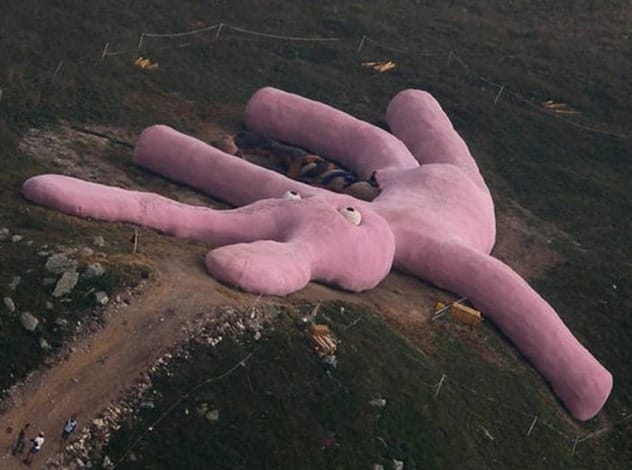
Imagine hiking through the breathtaking Italian Alps, surrounded by rolling hills and crisp mountain air, only to stumble upon an enormous, bright pink, stuffed rabbit splayed across a mountainside. This isn’t a hallucination; it’s an art installation.
Created by the Viennese art collective Gelitin, this colossal bunny was placed on the side of a mountain in 2005 and is expected to remain there, gradually decomposing, until around 2025. The rabbit, stuffed with straw, measures 200 feet long—nearly two-thirds the length of an American football field. And yes, those are its colorful, stuffed entrails spilling out; it was designed that way. Visitors are encouraged to climb and lounge on this massive, partially eviscerated pink creature. Why a giant rabbit? One group member explained it’s to make you feel “small as a daisy.”
4. The Ängelholm UFO Memorial, Sweden

In a quiet park in a suburb of Ängelholm, Sweden, stands what initially might seem like a peculiar piece of playground equipment. It is, in fact, a memorial marking a UFO landing that supposedly occurred at that very spot on May 18, 1946. The sole witness was Gösta Carlsson, who later founded the Swedish pharmaceutical corporation Cernelle.
The monument is said to be a model of the actual UFO, and the concrete tracks around it represent its landing traces. Carlsson claimed not only to have seen the craft but also to have received recipes for remedies and medicines from its alien occupants, which he used to establish his company. Despite this intriguing story and the dedicated memorial, the event is largely disbelieved, even among UFO enthusiasts. Clas Svahn, co-author of a book with Carlsson about the incident, admitted there’s no compelling evidence it ever happened.
5. The Flagstaff Star, Boulder, Colorado

Residents and holiday visitors in the Boulder, Colorado area are treated to a special sight each year from November 19th until New Year’s Day. A gigantic star, illuminated on the side of Flagstaff Mountain, has overlooked the city every holiday season since 1947.
This tradition has faced its share of challenges, nearly being retired several times due to vandalism and energy consumption concerns. The star is formed by hundreds of light bulbs mounted on ten-foot steel poles, shielded from the weather. Fortunately, these days, the star is entirely wind-powered. While many locals make a pilgrimage to see the installation up close, for most, it serves as a cheerful, glowing symbol of the holiday season.
6. Devil’s Pool, Victoria Falls
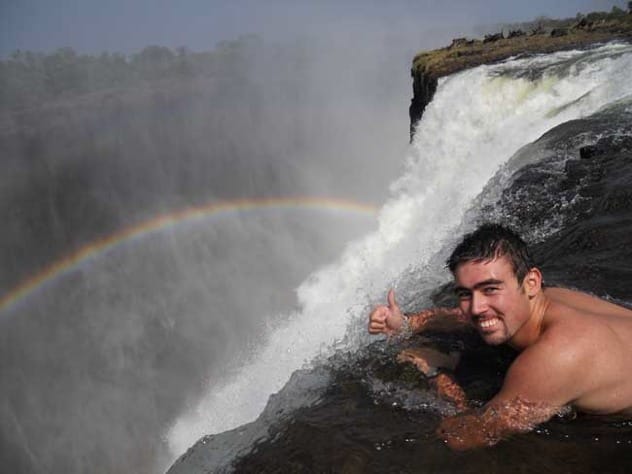
Photos of people lounging at the precipice of a massive waterfall often look like elaborate hoaxes. However, at Victoria Falls, on Zambia’s border with Zimbabwe, Devil’s Pool is a very real and thrilling experience. During the dry season, when water levels are at their lowest, a natural rock wall forms an eddying pool right at the edge of the 328-foot drop.
To reach this unique swimming spot safely, visitors must navigate a specific path across rocks and shallow pools. Alternatively, one can jump in and be carried by the current towards what seems like certain doom, only for the current to dissipate as they reach the pool. Guests can then safely peek over the edge of the chasm. While secure enough even for children, visitors typically fall into two categories: those who calmly soak in the incredible surroundings, and those who can’t stop screaming.
7. Musical Roads
Most drivers are familiar with the rumbling sound created by raised pavement markers. A few clever engineers around the world have harnessed this effect, arranging markers of varying heights to make stretches of road that play a melody as your car drives over them.
The first “musical road” was built in Denmark in 1995, with Japan quickly adopting the idea. One of the most famous examples is the road constructed near Lancaster, Pennsylvania, for a 2008 Honda Civic commercial. This road uses grooves cut into the asphalt to play a portion of the “William Tell Overture.” Only a handful of these musical roads exist globally, and they’re usually marked with signs, likely to prevent sleepy commuters from questioning their sanity or their car’s sudden musical talents.
8. The Morning Glory Spillway, Lake Berryessa
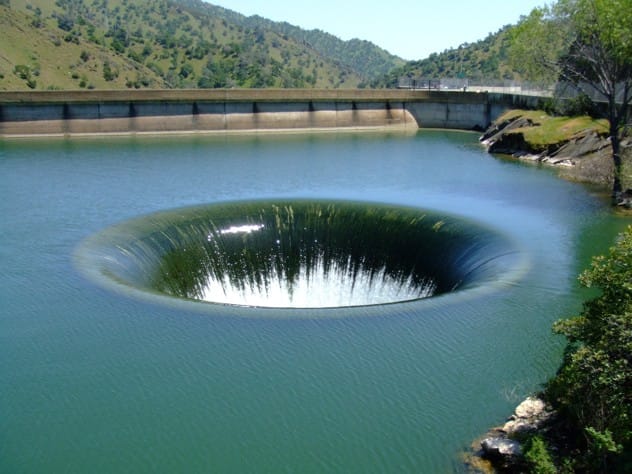
The Morning Glory Spillway at Lake Berryessa in California’s Napa Valley is, quite simply, the largest of its kind in the world. This massive drain, part of the Monticello Dam, helps relieve pressure on the dam. That’s the practical explanation for the almost unbelievable sight of a giant hole seemingly swallowing the lake.
Located just 200 feet from the dam, this concrete spillway—colloquially known as the “glory hole”—is 72 feet wide and can drain an astounding 362,000 gallons of water per second. Tragically, in 1997, a UC Davis student was sucked into the spillway and drowned, the only known fatality, as it’s an area wise swimmers avoid. Photos of it in action often resemble a Photoshop creation or the ominous beginnings of a black hole forming beneath the water.
9. Horsetail Fall Firefall, Yosemite
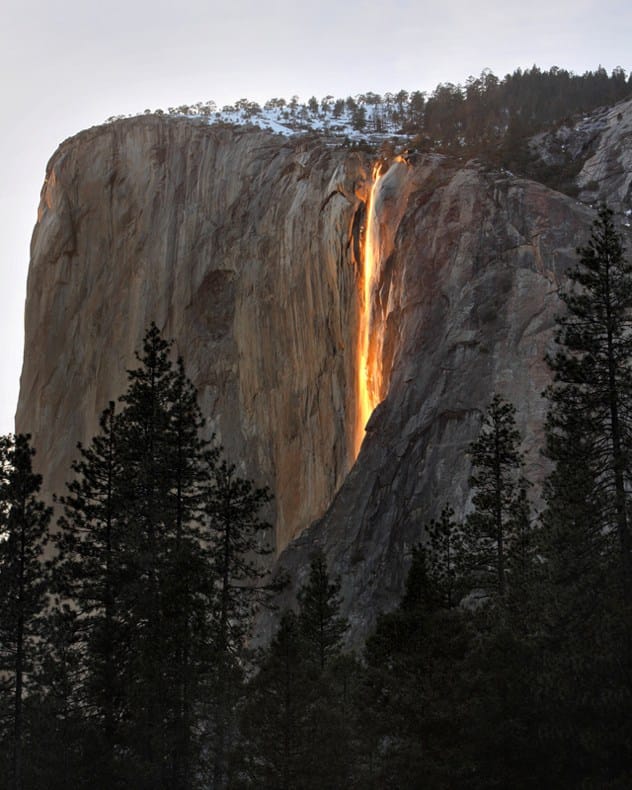
Yosemite National Park is renowned for its breathtaking scenery, and Horsetail Fall is one of its most stunning highlights, especially during a brief period each year. For a few days in February, the 2,000-foot cascade spectacularly appears to catch fire.
This “firefall” is a natural trick of light. Around 5:30 PM on clear evenings in mid to late February, the setting sun hits the waterfall at just the right angle, illuminating it with fiery oranges and reds. The effect is so convincing that some visitors find it hard to believe it isn’t actual lava, even after seeing the water moments before. Interestingly, in the late 1800s, a hotel owner used to push hot embers over the cliff’s edge as a nighttime show, a practice both hazardous and far less spectacular than nature’s own display.
10. Neptune Memorial Reef, Florida

Off the coast of Key Biscayne, Florida, about three miles out and 40 feet below the surface, scuba divers can discover an extraordinary underwater world: the Neptune Memorial Reef. Already the world’s largest man-made reef, it’s set to become even more expansive over the next decade.
This stunning underwater installation features statues, massive columns, arches, and even underwater roads leading to a central area. But there’s more to it than meets the eye; it’s an underwater cemetery or mausoleum. The cremated remains of individuals are mixed into the cement used to create these features, with memorial plaques marking their final resting place. Some have paid thousands for this unique interment. When completed, the Reef is projected to cover sixteen acres and accommodate up to 125,000 remains, creating a truly remarkable and solemn underwater city.
The world is full of surprises, isn’t it? From quirky architectural decisions to breathtaking natural phenomena and peculiar memorials, these real-world Easter eggs remind us that there’s always something fascinating waiting to be discovered, often where we least expect it. They prove that reality can sometimes be stranger, and more wonderful, than fiction.
What do you think of these incredible finds? Have you ever stumbled upon a real-world Easter egg? Leave your comment below!


